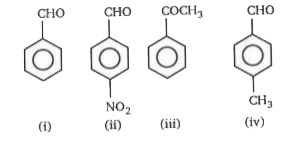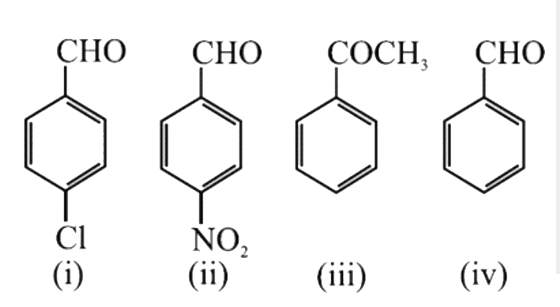Arrange the following compounds in increasing order of their reactivity in nucleophilic addition reactions.
(i) Ethanal, Propanal, Propanone, Butanone.
(ii) Benzaldehyde, p-Tolualdehyde, p-Nitrobenzaldehyde, Acetophenone.
Hint: Consider steric effect and electronic effect.
To arrange the given compounds in increasing order of their reactivity in nucleophilic addition reactions, we need to consider both steric effects and electronic effects.
Part (i): Ethanal, Propanal, Propanone, Butanone
1. Identify the Compounds:
- Ethanal (CH3CHO) - an aldehyde
- Propanal (C2H5CHO) - an aldehyde
- Propanone (CH3COCH3) - a ketone
- Butanone (C3H7COCH3) - a ketone
2. Consider the Functional Groups:
- Aldehydes are generally more reactive than ketones in nucleophilic addition reactions due to less steric hindrance and greater electrophilicity.
3. Assess Steric Hindrance:
- Ethanal has the least steric hindrance as it has only one alkyl group.
- Propanal has slightly more steric hindrance due to the presence of a larger ethyl group.
- Propanone and Butanone are ketones and have two alkyl groups, making them bulkier and less reactive.
4. Order of Reactivity:
- Ethanal (most reactive) > Propanal > Butanone > Propanone (least reactive)
Thus, the increasing order of reactivity for part (i) is:
Propanone < Butanone < Propanal < Ethanal
Part (ii): Benzaldehyde, p-Tolualdehyde, p-Nitrobenzaldehyde, Acetophenone
1. Identify the Compounds:
- Benzaldehyde (C6H5CHO) - an aldehyde
- p-Tolualdehyde (C6H4(CH3)CHO) - an aldehyde with a methyl group
- p-Nitrobenzaldehyde (C6H4(NO2)CHO) - an aldehyde with a nitro group
- Acetophenone (C6H5COCH3) - a ketone
2. Consider the Electronic Effects:
- Electron-withdrawing groups (like NO2) increase the reactivity of the carbonyl carbon by stabilizing the positive charge that develops during the nucleophilic attack.
- Electron-donating groups (like CH3) decrease the reactivity by increasing electron density on the carbonyl carbon.
3. Assess Reactivity:
- Acetophenone is a ketone and is less reactive due to steric hindrance and electron-donating effects of the phenyl and methyl groups.
- p-Tolualdehyde has an electron-donating methyl group, making it less reactive than benzaldehyde.
- Benzaldehyde is more reactive than p-Tolualdehyde but less than p-Nitrobenzaldehyde.
- p-Nitrobenzaldehyde, having an electron-withdrawing nitro group, is the most reactive.
4. Order of Reactivity:
- Acetophenone (least reactive) < p-Tolualdehyde < Benzaldehyde < p-Nitrobenzaldehyde (most reactive)
Thus, the increasing order of reactivity for part (ii) is:
Acetophenone < p-Tolualdehyde < Benzaldehyde < p-Nitrobenzaldehyde
Final Answers:
1. Part (i): Propanone < Butanone < Propanal < Ethanal
2. Part (ii): Acetophenone < p-Tolualdehyde < Benzaldehyde < p-Nitrobenzaldehyde
- Ethanal (CH3CHO) - an aldehyde
- Propanal (C2H5CHO) - an aldehyde
- Propanone (CH3COCH3) - a ketone
- Butanone (C3H7COCH3) - a ketone
- Aldehydes are generally more reactive than ketones in nucleophilic addition reactions due to less steric hindrance and greater electrophilicity.
- Ethanal has the least steric hindrance as it has only one alkyl group.
- Propanal has slightly more steric hindrance due to the presence of a larger ethyl group.
- Propanone and Butanone are ketones and have two alkyl groups, making them bulkier and less reactive.
- Ethanal (most reactive) > Propanal > Butanone > Propanone (least reactive)
Propanone < Butanone < Propanal < Ethanal
- Benzaldehyde (C6H5CHO) - an aldehyde
- p-Tolualdehyde (C6H4(CH3)CHO) - an aldehyde with a methyl group
- p-Nitrobenzaldehyde (C6H4(NO2)CHO) - an aldehyde with a nitro group
- Acetophenone (C6H5COCH3) - a ketone
- Electron-withdrawing groups (like NO2) increase the reactivity of the carbonyl carbon by stabilizing the positive charge that develops during the nucleophilic attack.
- Electron-donating groups (like CH3) decrease the reactivity by increasing electron density on the carbonyl carbon.
- Acetophenone is a ketone and is less reactive due to steric hindrance and electron-donating effects of the phenyl and methyl groups.
- p-Tolualdehyde has an electron-donating methyl group, making it less reactive than benzaldehyde.
- Benzaldehyde is more reactive than p-Tolualdehyde but less than p-Nitrobenzaldehyde.
- p-Nitrobenzaldehyde, having an electron-withdrawing nitro group, is the most reactive.
- Acetophenone (least reactive) < p-Tolualdehyde < Benzaldehyde < p-Nitrobenzaldehyde (most reactive)
Acetophenone < p-Tolualdehyde < Benzaldehyde < p-Nitrobenzaldehyde
1. Part (i): Propanone < Butanone < Propanal < Ethanal
2. Part (ii): Acetophenone < p-Tolualdehyde < Benzaldehyde < p-Nitrobenzaldehyde
Topper's Solved these Questions
- ALDEHYDES, KETONES AND CARBOXYLIC ACIDSBOOK - NCERT ENGLISHCHAPTER - ALDEHYDES, KETONES AND CARBOXYLIC ACIDSEXERCISE - Exercise
28 Videos
- ALCOHOLS, PHENOLS AND ETHERSBOOK - NCERT ENGLISHCHAPTER - ALCOHOLS, PHENOLS AND ETHERSEXERCISE - EXERCISE
45 Videos
- AMINESBOOK - NCERT ENGLISHCHAPTER - AMINESEXERCISE - Exercise
23 Videos
Similar Questions
Arrange the following compounds in an increasing order of their reactivity in nucleophilic addition reations: Ethanal, propanal, propanone, butanone.
View SolutionArrange the following compounds in an increasing order of their reactivity in nucleophilic addition reations: Ethanal, propanal, propanone, butanone.
View Solution
Knowledge Check
Arrange the following compounds in increasing order of their reactivity in nucleophilic addition reactions.
Ethanal, Propanal, Propanone, ButanoneAButanone lt Propanone lt Propanal lt EthanalBPropanone lt Butanone lt Ethanal gt PropanalCPropanal lt Ethanal lt Propanone lt ButanoneDEthanal lt Propanal lt Propanone lt ButanoneArrange the following carbonyl compounds in decreasing order of their reactivity in nucleophilic addition reaction.
 Aii>iii>i>ivBii>i>iv>iiiCiii>ii>i>ivDiii>i>iv>ii
Aii>iii>i>ivBii>i>iv>iiiCiii>ii>i>ivDiii>i>iv>iiArrange these compounds in decreasing order of reactivity for the nucleophilic addition reaction.
(I) Acid chloride (II) Aldehyde (III) Ketone (IV) EsterAI>II>III>IVBIV>III>II>ICIII>II>I>IVDI>IV>II>III
Arrange the following compounds in an increasing order of their reactivity in nucleophilic addition reations: Ethanal, propanal, propanone, butanone.
View SolutionArrange the following carbonyl compounds in decreasing order of their reactivity in nucleophilic addition reaction :

View SolutionArrange the following in the order of their increasing reactivity in nucleophilic substitution reactions.
CH3F,CH3Cl,CH3Br,CH3I
View SolutionWrite down decreasing order of nucleophilic addition reaction of following
Propanal, Butanone, Propanone, Benzaldehyde
View SolutionWrite down decreasing order of nucleophilic addition reaction of following
Propanal, Butanone, Propanone, Benzaldehyde
View Solution
